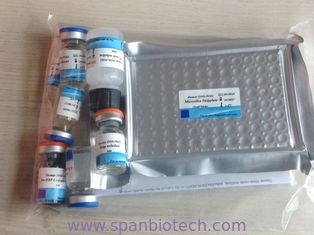|
|
Human Selenium Binding Protein 1(SELENBP1) ELISA Kit
|
Product Details:
Payment & Shipping Terms:
|
| Specificity: | 100% |
|---|
Human Selenium Binding Protein 1(SELENBP1) ELISA Kit
Sample Types Validated:Serum, blood plasma,Saliva, Urine, and other related tissue Liquid.
Intended Use
This kit is used to assay the selenium binding protein 1(SELENBP1)in the sample of Human’s serum, blood plasma, and other related tissue Liquid.
Test principle
The kit uses a double-antibody sandwich enzyme-linked immunosorbent assay (ELISA) to assay the level of Human selenium binding protein 1(SELENBP1)in samples. Add selenium binding protein 1(SELENBP1) to monoclonal antibody Enzyme well which is pre-coated with Human selenium binding protein 1(SELENBP1)monoclonal antibody, incubation; then, add selenium binding protein 1(SELENBP1)antibodies labeled with biotin, and combined with Streptavidin-HRP to form immune complex; then carry out incubation and washing again to remove the uncombined enzyme. Then add Chromogen Solution A, B, the color of the liquid changes into the blue, And at the effect of acid, the color finally becomes yellow. The chroma of color and the concentration of the Human Substance selenium binding protein 1(SELENBP1)of sample were positively correlated.
Materials supplied in the Test Kit
| 1 | Standard(96ng/ml) | 0.5ml | 7 | Chromogen Solution A | 6ml |
| 2 | Standard diluent | 3ml | 8 | Chromogen Solution B | 6ml |
| 3 | Microelisa Stripplate | 12w×8s | 9 | Stop Solution | 6ml |
| 4 | Str- HRP-Conjugate Reagent | 6ml | 10 | Instruction | 1 |
| 5 | 30×wash solution | 20ml | 11 | Closure plate membrane | 2 |
| 6 | Biotin-SELENBP1 Ab | 1ml | 12 | Sealed bags |
1 |
Materials required but not supplied
1. 37 ℃ incubator 2. Standard Enzyme reader
3. Precision pipettes and Disposable pipette tips 4. Distilled water
5. Disposable tubes for sample dilution 6. Absorbent paper
Important Notes
Beening taken out from the 2-8℃ environment, the kit should be balanced 30 minutes in the ambient temperature then use. If the Coated plates of Enzyme haven’t been used up after opened, the remaining plates should be stored in Sealed bag.
2. For each step, add Sample with sample injector which should be calibrated frequently, in order to avoid unnecessary experimental tolerance.
3. he operation shall be carried out accordance to the instructions strictly. And test results must be based on the readings of the Enzyme reader.
4. In order to avoid cross-contamination, it is forbidden to re-use the suction head
and seal plate membrane in your hands.
5. All samples, washing buffer and each kind of reject should according to infective material process.
6. The idle agents shall be put up or covered. Do not use reagent with different batches. And use them before expired date.
7. The substrate B is light-sensitive. Prolonged exposure to light is forbidden.
Washing method
Manually washing method: shake away the remain liquid in the enzyme plates; place some bibulous papers on the test-bed, and flap the plates on the upside down strongly. Inject at least 0.35ml after-dilution washing solution into the well, and marinate 1~2 minutes. Repeat this process according to your requirements.
Automatic washing method: if there is automatic washing machine, it should only be used in the test when you are quite familiar with its function and performance.
Precision
Intra-assay Precision (Precision within an assay): 3 samples with low, middle and high level Human SELENBP1 were tested 20 times on one plate, respectively.
Inter-assay Precision (Precision between assays): 3 samples with low, middle and high level Human SELENBP1 were tested on 3 different plates, 8 replicates in each plate.
CV(%) = SD/meanX100
Intra-Assay: CV<10%
Inter-Assay: CV<12%
Specimen requirements
1. Can’t detect the sample which contain NaN3, because NaN3 inhibits HRP
active.
2. extract as soon as possible after Specimen collection,and according to the relevant literature, and should be experiment as soon as possible after the extraction. If it can’t, specimen can be kept in -20 ℃ to preserve, Avoid repeated freeze-thaw cycles.
3. serum- coagulation at room temperature 10-20 mins,centrifugation 20-min at the speed of 2000-3000 r.p.m. remove supernatant, If precipitation appeared, Centrifugal again.
4.plasma-use suited EDTA or citrate plasma as an anticoagulant,mix 10-20 mins ,centrifugation 20-min at the speed of 2000-3000 r.p.m. remove supernatant, If precipitation appeared, Centrifugal again.
5. Urine-collect sue a sterile container, centrifugation 20-min at the speed of 2000-3000 r.p.m. remove supernatant, If precipitation appeared, Centrifugal again. The Operation of Hydrothorax and cerebrospinal fluid Reference to it.
6.cell culture supernatant-detect secretory components, collect sue a sterile container, centrifugation 20-min at the speed of 2000-3000 r.p.m. remove supernatant,detect the composition of cells, Dilute cell suspension with PBS(PH7.2-7.4), Cell concentration reached 1 million / ml, repeated freeze-thaw cycles, damage cells and release of intracellular components, centrifugation 20-min at the speed of 2000-3000 r.p.m. remove supernatant, If precipitation appeared, Centrifugal again.
7.Tissue samples- After cutting samples, check the weight,add PBS(PH7.2-7.4), Rapidly frozen with liquid nitrogen, maintain samples at 2-8℃ after melting,add PBS(PH7.4), Homogenized by hand or Grinders, centrifugation 20-min at the speed of 2000-3000 r.p.m. remove supernatant.
Span Biotech Ltd.
Tel: +86(755)89589611
WhatsAPP:+8618823462100 (WhatsApp)
Web:www.spanbio.com www.spanbiotech.com
Contact Person: Ms. Anna Lee
Tel: +86-755-89589611
Fax: 86-755-89580096
-
Albulin (Alb ) Elisa Test Kit for Diagnostic Use
-
β2-Microglobulin (β2-MG) Elisa Test Kit for Diagnostic Use
-
Carbohydrate Antigen 50 (CA-50) Elisa Diagnostic Kit for Diagnostic Use
-
Carbohydrate Antigen 19-9 (CA19-9) Elisa Test Kit for Diagnostic Use
-
Carbohydrate Antigen 15-3 (CA15-3) Elisa Test Kit for Diagnostic Use
-
Carbohydrate Antigen 125(CA-125)Elisa Test Kit for Diagnostic Use




